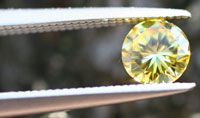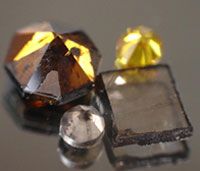Synthetic Diamonds
For people who can't afford real diamonds or want a 100-percent guarantee that their diamond is conflict-free, synthetic diamonds are a good substitute. For many years, the only synthetic option available was cubic zirconia, but now consumers can also choose from Moissanite and man-made diamonds.
Cubic zirconia, commonly called CZ, is a laboratory gem that has been on the market since 1976. It's a hard gem (8.5 on the Mohs Scale), but it's not as hard as diamond. On the one hand, CZ is compositionally superior to diamond. CZ has greater brilliance and sparkle, it's entirely colorless and it has no inclusions. However, most consumers agree that CZ is simply too perfect -- it looks artificial even to the naked eye. Because of this, some CZ manufacturers have started producing the gem with colored tints and inclusions so that it more closely resembles diamond.
Advertisement
Moissanite has become CZ's biggest synthetic rival. Moissanite became available in 1998, and it's even more similar to diamond in composition and appearance. Moissanite is harder than CZ, but at 9.5 on the Mohs Scale, it is still softer than diamond. Moissanite's color is faintly yellow or green, and the tint becomes more apparent in larger stones. It also has small, stretch-mark-like inclusions that form during its growing process. Like CZ, Moissanite is more radiant than diamond, but this quality is considered a disadvantage rather than an advantage.

The closest synthetic approximation to diamond is a man-made diamond. Unlike CZ and Moissanite, man-made diamonds are pure carbon. The Gemological Institute of America (GIA) recognizes these as real diamonds from a compositional perspective. But, the man-made diamonds don't have the rich geological history that natural diamonds do. Laboratories simulate the heat and pressure from the Earth's mantle that create natural diamonds. For the synthetic manufacturers and the consumers, diamonds come down to a matter of time and money: days versus millions of years, thousands of dollars versus tens of thousands of dollars or more (man-made diamonds sell for about 30 percent less than natural ones) [source: MSN]. If you want a uniquely colored, relatively inexpensive diamond (it will cost less than a natural colored diamond), you can find man-made ones in shades of orange, yellow, pink and blue. Finding a large diamond will prove a greater challenge -- most man-made diamonds weigh less than one carat. If you want the best synthetic has to offer, man-made diamonds are a no-brainer. Even jewelers can have a hard time telling them apart from natural ones. To prevent retailers from passing off man-made diamonds as natural ones, the GIA is selling machines that will help jewelers easily distinguish between the two.
It may come as no surprise that the developer behind these machines is none other than the king of the natural diamond industry: De Beers.
For more information on diamonds and related topics, check out the links below.
Related HowStuffWorks Articles
- How Moissanite Jewels Work
- Diamond Quiz
- How Volcanoes Work
- How Carbon-14 Dating Works
- How the African Diamond Trade Works
- What are the "four Cs" that people talk about when buying a diamond?
- How does a "carat" relate to a "karat"?
More Great Links
Sources
- "The Art of Cutting Diamonds: The Manner of Preparing the Gems for the Market." The New York Times. 9/7/1885 (10/9/2007). http://query.nytimes.com/gst/abstract.html?res= 9F05E3DD1139E533A25754C0A96E9C94649FD7CF
- "Blood Diamonds- Conflict Diamonds- What is the Kimberley Process?" Geology.com. (10/9/2007) http://www.geology.com/articles/blood-diamonds.shtml
- "Bushmeat." The Animal Welfare Institute. (10/9/2007). http://209.85.165.104/search?q=cache:Sb2nf0kvVlUJ:www.awionline.org/ othercampaigns/Bushmeat/bushmeat.pdf+Bushmeat+the+taste +of+extinction&hl=en&ct=clnk&cd=2&gl=us
- "Conflict Diamonds." United Nations Department of Public Information. 3/21/2001. (10/9/2007). http://www.un.org/peace/africa/Diamond.html
- "Cubic Zirconia." Estate Antique Jewelry Sarasota Gold and Silver. (10/9/2007). http://www.sarasotagoldandsilver.com/info/Cubic_zirconia.php
- Hussain, Sakina Sadat and Peter Cahill. "A Diamond's Journey." MSNBC.com. (10/10/2007). http://www.msnbc.msn.com/id/15842546/1
- JJKent, Inc. "About the Early Methods of Cleaving, Sawing, and Cutting Diamonds." 2004 (10/9/2007). http://www.jjkent.com/articles/methods-cleaving-sawing-cutting- diamonds.htm
- LifeGem. "LifeGem. More than a Breakthrough." 2006 (10/9/2007) http://www.lifegem.com/secondary/LGProcess2006.aspx
- "Moissanite." Diamonds are Forever Index. (10/9/2007). http://www.diamonds-are-forever.org/uk/moissanite.htm
- Mulrean, Jennifer. "Man-made diamonds: a girl's new best friend?" MSN Money. (10/9/2007). http://moneycentral.msn.com/content/SavingandDebt/P97816.asp
- NOVA. "The Diamond Deception." 2/1/2000 (10/15/2007) NOVA Transcripts: PBS. http://www.pbs.org/wgbh/nova/transcripts/2703diamond.html
- Roach, John. " 'Blood Diamonds' and How to Avoid Buying Illicit Gems." National Geographic News. 12/8/2006 (10/9/2007). http://www.news.nationalgeographic.com/news/pf/89380450.html
